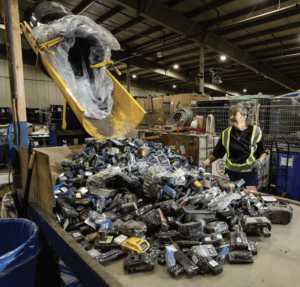Toronto, Ontario — The full video replay of Collision Repair magazine’s EV Repair Tour, supported by Fix Network, is available for viewing.
On Aug. 23, more than 100 automotive aftermarket professionals gathered at Fix Network’s Milton, Ont., training centre to hear electric vehicle experts deliver presentations on how electrification of the Canadian vehicle parc will impact the automotive industry as a whole, particularly the collision repair and recycling markets.
Two presentations that will be of particular interest to recyclers are from David Giles, EV expert with Powered EV Consulting, who has plenty of experience rebuilding written-off Teslas, and Joseph Chung of Call2Recycle, who heads the not-for-profit’s battery recycling efforts across Canada.
In his presentation, Giles discussed the reality of battery rebuilding as a business in the near future–something that is “very limited today,” he said.
“If you want to get into battery rebuilding, it’s very limited today. These batteries have eight-year warranties; if you’re looking for worn-out batteries so you can offer services to rebuild them…well, it’s going to be a long time.”
According to battery cycle time tests conducted at Dalhousie University and other notable organizations, Giles said EV batteries are capable of more than 2,000 charge cycles before end-of-life.
“If that vehicle gets a range of 400 kilometres per charge–you’re looking at 800,000 kilometres on that battery pack.
“That car is probably going to wear out before the battery.”
Chung’s presentation covered details of the electric vehicle battery lifecycle, from manufacturing to processing and repurposing–or recycling, in some cases. He discussed the long-term importance of creating a “circular economy” of resources since the lithium and precious metals found in rechargeable batteries are so often finite, and recovering them can help to establish a continuous cycle of battery production.
Chung also offered some helpful identifiers in verifying battery damage, such as looking for any dents in the battery shell, gas leaks, or evidence of smoke.
In regard to immediate industry safety, Chung emphasized that “identifying [any potential] damage is critical for safety” and for the recovery process. Before a battery can be recovered, repurposed, or recycled, potential damage must be recorded–further highlighting the importance of a facility’s documentation processes in the modern market. He said that identifying any potential damage is crucial since defects to rechargeable batteries can create a “cascading effect” wherein, “a little fender bender [to an EV] could have damaged a couple of the cells within the battery module.”
On this note, Chung shared an incident in New Jersey in July 2023 in which: “one defective battery went unnoticed” and caused an entire facility to go up in flames, resulting in over one million dollars in clean-up damages alone.
Click here to read more on Chung’s presentation, including more information on procedures and policies for transporting EOL EV batteries.
The full recording of Collision Repair mag’s EV Repair Tour, supported by Fix Network, is available below.
Collision Repair magazine’s EV Repair Tour will stop in:



























